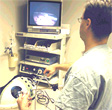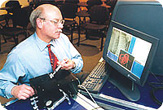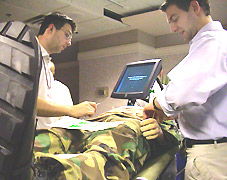|
|
  |
|
 |
 Steven
Dawson, MD
Steven
Dawson, MD
email: sdawson@partners.org
dawson.steven@mgh.harvard.edu
Phone: 617.768.8781
Institution:
Massachusetts General Hospital
Current Professional Experience:
Associate Professor of Radiology at Harvard
Core Program Position:
Program Leader, Simulation
Background:
Steve Dawson, MD, program leader for The Simulation Group, is an interventional
radiologist at Massachusetts General Hospital. Steve graduated from Tufts
Medical School, and then did his radiology residency and a two year post-doctoral
fellowship in Interventional Radiology at Mass General. He holds faculty
appointments as Associate Professor at Harvard Medical School and Visiting
Scientist at the Massachusetts Institute of Technology.
In 1994, he saw a primitive
simulator and a light bulb lit up: he recognized that advances in computing,
haptics, and graphics could be applied to medical education to change
medicine’s tradition of learning on humans. Since then, Steve has
made the development of effective, proven medical simulators his major
research focus, though he still has the most fun during his regularly
scheduled clinical rotations in the hospital, treating patients and teaching
the next generation of interventional radiologists.
“Right now, we still
use the same teaching model that Egyptians used 4,000 years ago”,
he says. “If I’m a doctor in a teaching hospital and a sick
person comes in, I learn on that person. If I need to learn how to treat
a particular disease and no one with that disease shows up, I‘m
out of luck. And whoever I’m working on is someone’s mother,
father, son or daughter. This system worked fine for all those years when
there was no other way to teach young doctors, but we are at a crucial
time in medical education, where revolutions in computing, mathematics,
engineering and education surround us. Our challenge in medicine is to
grab the best of these revolutions and create a new way of medical learning.
But we need to do it carefully and we need to know that when we make a
better way, it will work as well as, or better than, the old ways, because
we can’t go backwards.”
Steve believes that physicians
must be central to the creation of educational systems. “Docs know
best what docs need to know. We know what will convince us that it’s
time to change our ways. Without physician involvement from first ideas
through final validation, simulation designers may spend months or years
in wasted effort. And before effective simulators are ready, rigorous
scientific research has to be done, so that we don’t just create
elaborate video games and pass them off as medical training systems.”
Steve assembled this talented team to address these difficult scientific
hurdles in engineering, mathematics, computer science, education, and
system design.
The Simulation Group welcomes
these challenges. Solving the scientific problems of medical education
through simulation is our Big Hairy Audacious Goal. It keeps us interested
and it makes life fun.
Back to the list of Researchers

